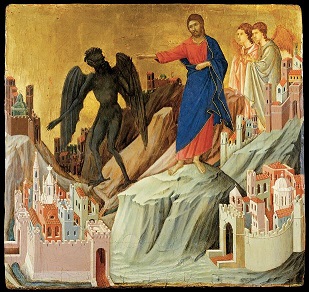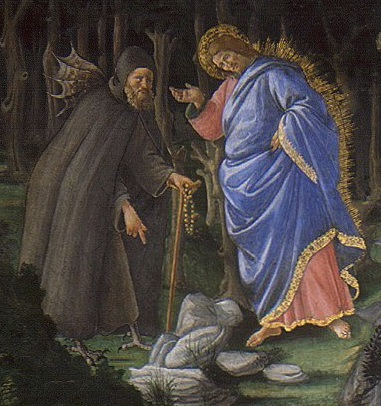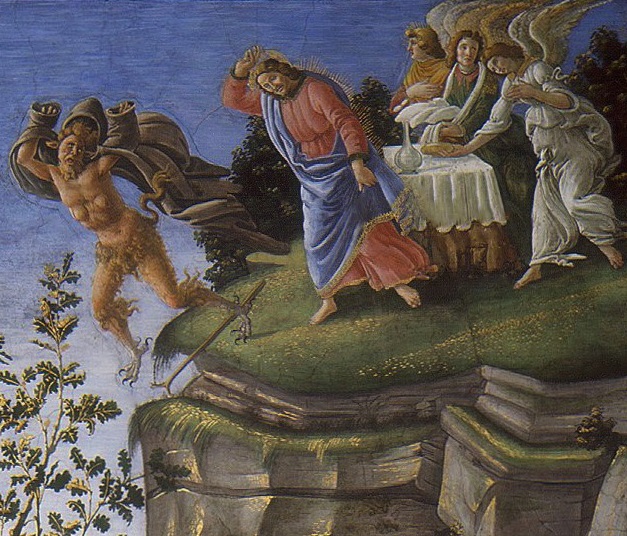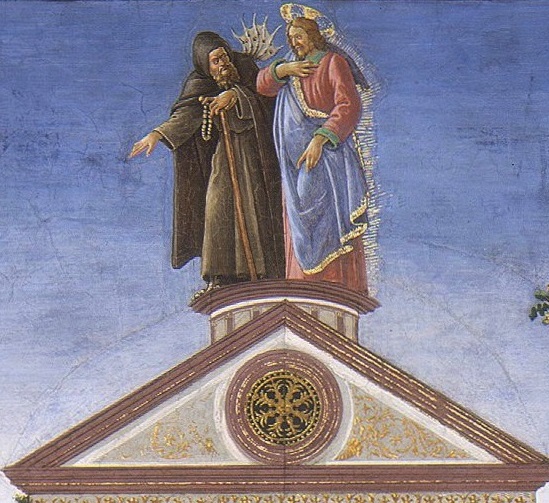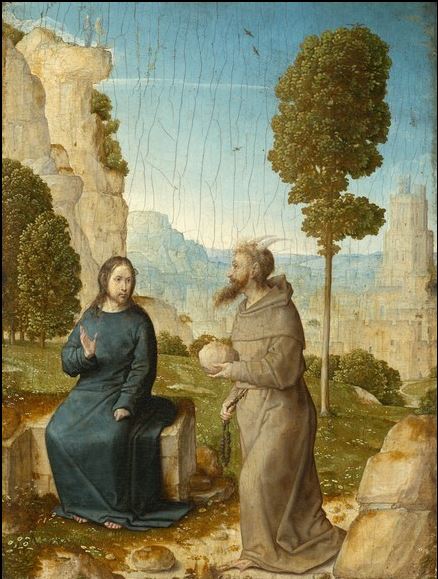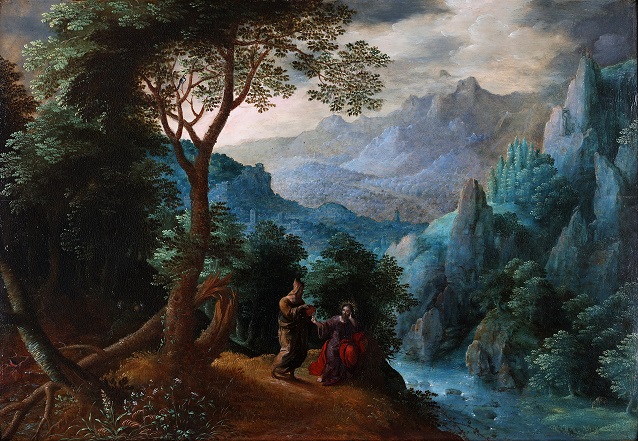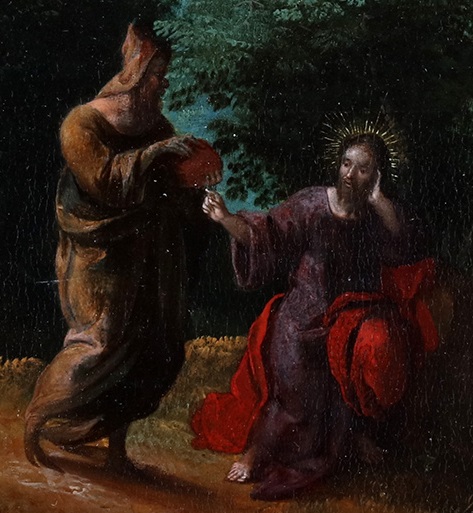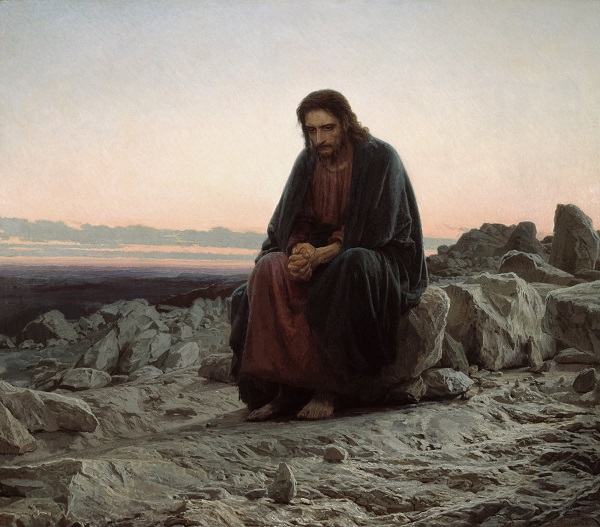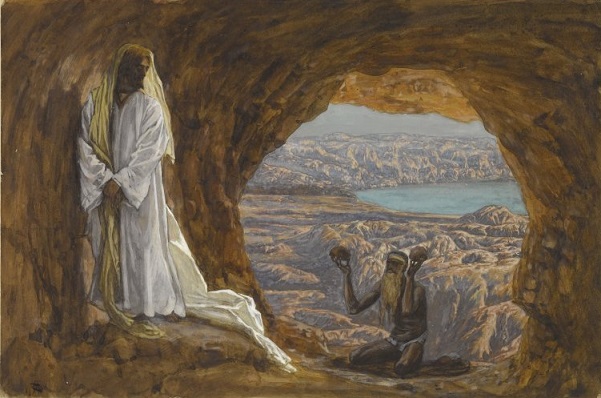Many artists have painted about this part of Jesus' life, when he was in the wilderness for 40 days. Below are some of those paintings. If you click a picture, you will see a much larger version. For some of the pictures, you can click on the larger version and see an even LARGER version. The first painting was made in about 1300, by the artist named Duccio di Buoninsegna. The painting is called "Temptation on the Mountain." It is part of a large piece of art called "Maestą." This painting is on the backside of the large piece of art (the Maestą), and it is next to another painting that we looked at before, a painting about when Jesus called Andrew and his brother Simon Peter to be Apostles, to be fishers of men. The large piece of art was made to be put on an altar inside a huge church building in Italy. The piece of art had two sides, and it had different paintings on each side. (Side 1.) (Side 2.) The art piece was in that church for about 450 years. Then, the large piece of art was cut into pieces, leaving many individual paintings, and the individual paintings are now in many places around the world. The next painting was made in the year 1482, by Sandro Botticelli. It is a fresco, and it is painted on a wall at the Sistine Chapel, in Rome, Italy. It is called "Temptation of Christ." It is 18 feet wide and 11 feet high, larger than the end wall in the classroom. There are many things happening in the painting. Let's look at three parts of the painting. We'll begin in the upper-left corner of the painting. In that corner, the artist painted the devil coming to Jesus when he was in the wilderness for 40 days. Jesus was hungry. The devil tempted him by saying, "If you are the Son of God, tell this stone to become bread." Here is that portion of the painting. The devil is portrayed as pretending to be a man, but you see his feet that look like bird feet. The devil is pointing to stones on the ground.
In the upper-right corner, the artist
painted the devil in a high place with Jesus, looking
down over many towns and cities, and the devil said,
"If you worship me, it will all be yours."
In the center of the painting, at the
top, the artist painted the devil and Jesus standing on
the highest point of the temple in Jerusalem, where the
devil said to Jesus, "If You are the Son of God,
throw Yourself down from here." The devil said that,
if Jesus was the Son of God, God would tell angels to
protect Jesus, so that Jesus would not fall to the
ground.
The next painting was made in about 1502, by Juan de Flandes. It is small, only about eight inches high and about six inches wide. It's at the National Gallery of Art in Washington, D.C. It's an oil painting. The next painting was made in 1600, a little over 400 years ago. The artist's name was Tobias Verhaecht, and the painting is called "The Temptation of Christ." It's an oil painting, about two feet wide and almost a foot-and-a-half high. The artist liked to paint mountains and landscapes. Jesus and the devil are the smallest part of the painting. Here is a close-up of the devil trying to tempt Jesus The devil is holding a large brick of gold. Look at the devil's feet: They look like the feet of a goat.
The next painting was made in 1872, by Ivan Nikolaevich Kramskoi. The painting is called "Christ in the Wilderness." The painting is six feet high and seven feet wide. It is in an art gallery in Moscow, Russia. The next painting was made in 1890, by James Tissot. The painting is called "Jesus Tempted in the Wilderness." Jesus appears to be inside a cave. The devil is kneeling on the ground outside the cave, holding up stones. The painting is gouache on paper. Gouach is kind of like watercolor paint, but it's thicker. This art is at a museum in Brooklyn, New York. It's about 13 inches wide and about nine inches high. Coloring sheet: In the style of James Tissot (works well with chalk)
|
